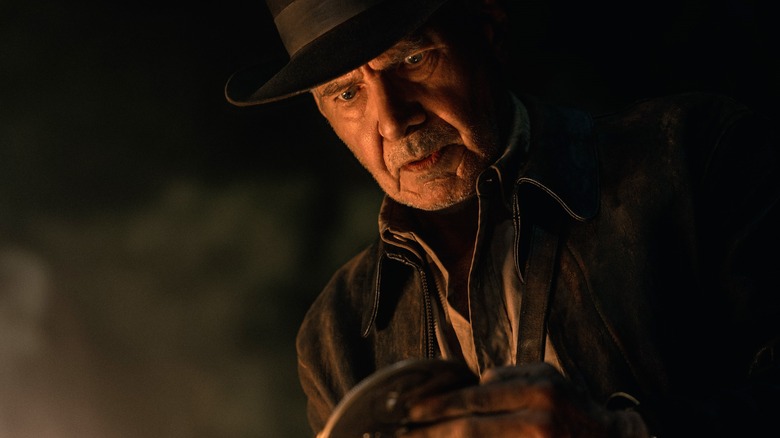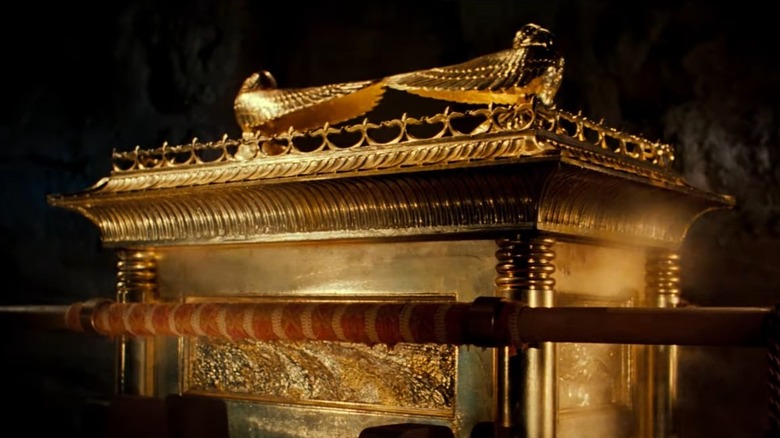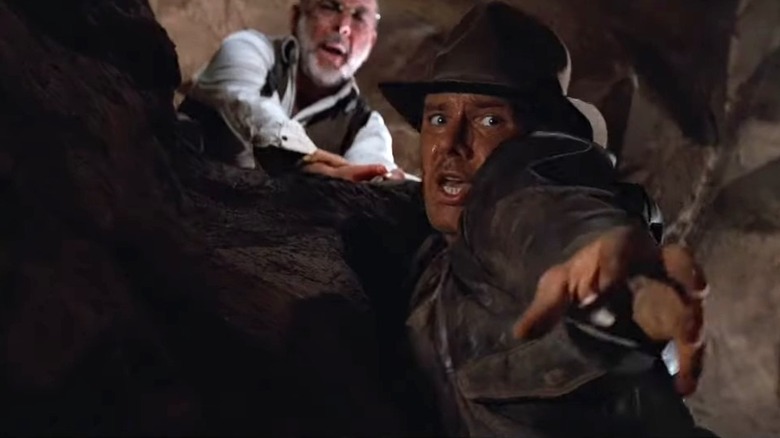Indiana Jones 5: How The Dial Of Destiny Breaks With Indy Tradition
Spoilers for "Indiana Jones and the Dial of Destiny."
Fans of the "Indiana Jones" franchise may have noticed in "Indiana Jones and the Dial of Destiny" that the story's conclusion reflects a different outcome than all of the Indy films that preceded it.
In the fifth and final chapter of the saga, Indiana Jones (Harrison Ford) finds Archimedes' Antikythera, aka the Dial of Destiny, a complex mechanism he's been searching for his entire life. Finding the invaluable artifact isn't an easy task for Indy and his goddaughter, Helena Shaw (Phoebe Waller-Bridge), however. Nazi scientist Jürgen Voller (Mads Mikkelsen) also wants the device so he can open a time portal to the past to change the course of history.
By keeping the dial in "Indiana Jones and the Dial of Destiny," the film series breaks with tradition in regard to where the ancient artifacts end up in the saga's first four chapters. Indy's goal, of course, is to usually display his invaluable findings in places where the public can view them, as he often grumbles, "It belongs in a museum." But apart from the occasional relic like Coronado's crucifix he successfully recovers in the first act of 1989's "Indiana Jones and the Last Crusade," the archaeologist's plans generally verge wayward.
The prize relics Indiana Jones recover disappear and reappear in a variety of ways
Indiana Jones has demonstrated throughout the course of the film saga that the adventurous life of an archeologist involves a lot of death-defying scenarios. In 1981's "Raiders of the Lost Ark" — which is the absolute best "Indiana Jones" movie, according to fans in a Looper survey — Indy recovers the Ark of the Covenant after an ancient ceremony that wipes out his Nazi enemies. However, the valiant efforts by Indy and his love-slash-adventure partner Marion Ravenwood (Karen Allen) are all for naught.
At the end of "Raiders of the Lost Ark," the Ark is sealed in a crate and is wheeled away into the seemingly endless environs of an unknown, top-secret U.S. government facility. The location is surprisingly revealed to be in a hangar at U.S. Air Force's Area 51 in Nevada during the events of 2008's "Indiana Jones and the Kingdom of the Crystal Skull," where during a chase scene in the hangar involving Indy, a crate is partially busted open to reveal the Ark.
Since the adventurer stumbles into his next adventure in 1984's "Indiana Jones and the Temple of Doom," government bureaucracy is not a factor, but Indy's conscience is. The artifacts at the center of the film, set in India, are three powerful Sankara Stones, which the villainous high priest Mola Ram (Amrish Puri) uses to possess and enslave children to mine in his underground lair. During his climactic battle with Mola Ram, Indy loses two of the stones, but returns the artifact and guides the freed children to the village they were stolen from.
Indy lets an artifact go in The Last Crusade and the Crystal Skull takes on a life of its own
Like the first two films in the saga, Indy is left empty-handed in 1989's "Indiana Jones and the Last Crusade" and 2008's "Indiana Jones and the Kingdom of the Crystal Skull." In "The Last Crusade," Indy and his father, Henry Jones Sr. (Sean Connery), pursue the Holy Grail, the powers of which are ultimately used to save Henry's life. The relic, though, falls through Indy's grasp as the temple where the grail is located crumbles. Indy tries to reach for the chalice after it falls into a crevice, but Henry urges his son to "let it go."
While Indy at least had a shot at keeping the Holy Grail in "The Last Crusade," there was no chance that he was going home with the titular alien object in "The Kingdom of the Crystal Skull." The skull, as it turns out, needed to be placed atop a headless skeleton, which activates a chain of events where an alien being is reanimated. All hopes for keeping any remnants from the scene are lost when the underground chamber in which the alien is housed turns out to be part of the interior of a UFO, which rises from its location beneath a Peruvian temple and vanishes.
So, while Indy at least has the Dial of Destiny in his possession for all of his troubles in the last 42 years, there's no guarantee that it will remain with the archeologist for long. After all, if Indy keeps his promise to his late adventure partner, Helena's father Basil Shaw (Toby Jones), he will destroy the dial to ensure that it never falls into the wrong hands.


